New dating is drawing closer parallels between Large Igneous Province events and modern climate change, says Howard Lee*.
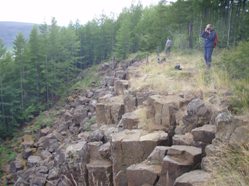 Picture: Large sill in the Siberian Traps © Linda Elkins-Tanton, DTM, Carnegie Institution
Picture: Large sill in the Siberian Traps © Linda Elkins-Tanton, DTM, Carnegie Institution
Unusually copious eruptions known as Large Igneous Provinces (LIPs) have long been associated with mass extinctions, ocean anoxic events and environmental stress in the geological record. These include the Permian 1 Triassic, 2 PETM, 3 Toarcian, 4 Cretaceous Ocean Anoxic Events, and the Columbia River Basalt event, 5 among others.The most lethal of these was the Permian Mass Extinction 251.9 million years ago, otherwise known as “The Great Dying,” which was the closest this planet has come to extinguishing all complex life on Earth. 6,1 For years the cause of the Permian Mass Extinction has been linked to the Siberian Traps eruptions through the mechanisms of volcanic CO2 and a cocktail of noxious gases, combined with burning coal deposits 7 and sill-baked methane emissions, 8 all of which produced a combination of toxic effects, ocean acidification and, most importantly, global warming. It led to a world where equatorial and tropical regions were lethally hot on land and in the oceans. 9 The cascading extinctions in ecosystems across the planet unfolded over tens of thousands of years, and it took 10 million years for the planet to recover. 9,1
 Until recently, the scale of the Permian Extinction was seen as just too massive, its duration far too long, and dating too imprecise for a sensible comparison to be made with today’s climate change. No longer.
Until recently, the scale of the Permian Extinction was seen as just too massive, its duration far too long, and dating too imprecise for a sensible comparison to be made with today’s climate change. No longer.
Picture: Earliest flood basalts of the Siberian Traps at Krasni Kamini (“Red Rocks”) near Talnakh, Sibera. The lavas here contain lumps of bitumen and burnt trees. © Linda Elkins-Tanton, DTM, Carnegie Institution
New dating
In “High-precision timeline for Earth’s most severe extinction,” published in PNAS on February 10, 1 authors Seth Burgess, Samuel Bowring, and Shu-zhong Shen employed new dating techniques on Permian-Triassic rocks in China, bringing unprecedented precision to our understanding of the event. They have dramatically shortened the timeframe for the initial carbon emissions that triggered the mass extinction from roughly 150,000 years 10 to between 2,100 and 18,800 years. 1 This new timeframe is crucial because it brings the timescale of the Permian Extinction event’s carbon emissions shorter by two orders of magnitude, into the ballpark of human emission rates for the first time.
How does this relate to today’s global warming? Most readers of Geoscientist will be familiar with the fact that climate and CO2 have changed hand-in-hand through geological time. Mostly these changes happened slowly enough that the long-term feedbacks of Earth’s climate system (deep oceans, ice sheets, rock weathering, sedimentation) had time to process them. This was true during the orbitally-induced glacial-interglacial cycles in the Pleistocene ice ages.
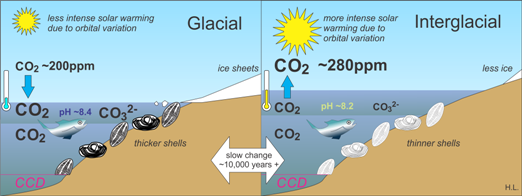 Diagram: How oceans responded to slow changes in insolation and CO2 feedback in the Pleistocene. © H.Lee based Based mainly on Zeebe, Annu. Rev. Earth Planet. Sci. 2012, with additional input from A. Ridgwell (personal communication)
Diagram: How oceans responded to slow changes in insolation and CO2 feedback in the Pleistocene. © H.Lee based Based mainly on Zeebe, Annu. Rev. Earth Planet. Sci. 2012, with additional input from A. Ridgwell (personal communication)
In warmer interglacials, more intense northern hemisphere insolation led to ice-sheet melting and warmer oceans that reached equilibrium with slightly higher CO2 concentrations in the atmosphere by adjusting their carbonate levels. In glacial times, with slightly less intense northern insolation, the cooler oceans dissolved more CO2, and carbonate levels adjusted accordingly. The changes occurred over gentle timescales of tens of thousands to hundreds of thousands of years – slow enough for feedbacks to keep pace. 11
Belches
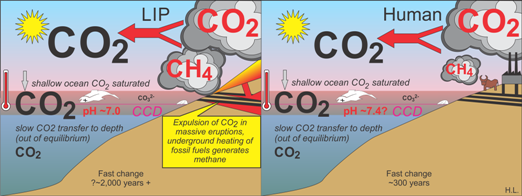 Diagram: How oceans respond to rapid carbon emissions by LIPs and humans © H.Lee based mainly on Zeebe, Annu. Rev. Earth Planet. Sci. 2012, with additional input from A. Ridgwell (personal communication)
Diagram: How oceans respond to rapid carbon emissions by LIPs and humans © H.Lee based mainly on Zeebe, Annu. Rev. Earth Planet. Sci. 2012, with additional input from A. Ridgwell (personal communication)
Rapid carbon belches, such as in the Permian and today, occur within the timeframe of fast climate feedbacks (surface ocean, water vapour, clouds, dust, biosphere, lapse rate, etc.), but take place more rapidly than the vast deep ocean reservoir and rock weathering can buffer. The carbon overwhelms the surface ocean and biosphere reservoirs so it has nowhere to go but the atmosphere, where it builds up rapidly, creating strong global warming via the greenhouse effect and feedbacks. Surface ocean waters turn near-acidic as they become increasingly saturated in CO2. 11 12 Oceans warm, so sea levels rise. Those symptoms should sound eerily familiar.
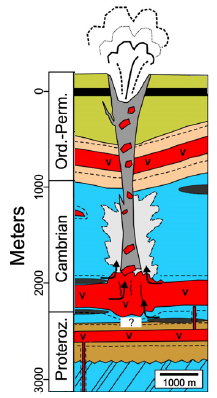 The Burgess et al. paper is the latest in a series that has shortened the timeframes of LIP events and strengthened the association between LIPs and extinction events. Blackburn et al. in their 2013 paper in Science, declared causality between Central Atlantic Magmatic Province (CAMP) eruptions and the end-Triassic extinctions, suggesting the pulse of carbon emissions occurred “near instantaneously”, and the main extinction event occurred in as little as 3000 years. 2
The Burgess et al. paper is the latest in a series that has shortened the timeframes of LIP events and strengthened the association between LIPs and extinction events. Blackburn et al. in their 2013 paper in Science, declared causality between Central Atlantic Magmatic Province (CAMP) eruptions and the end-Triassic extinctions, suggesting the pulse of carbon emissions occurred “near instantaneously”, and the main extinction event occurred in as little as 3000 years. 2
Diagram: PETM-implicated hydrothermal vent complexes in the central Vøring Basin emerging at top Paleocene strata, resembling the Siberian vent chimneys. Redrawn from Planke et al, Geol Soc Petroleum Geology Conference series v6, 2005
This idea was strengthened by Dal Corso et al., just this year in the J. Geol. Soc. who link the Carbon Isotope Excursion (from the carbon emission slug) to the initial eruptive phase of the CAMP. 13 The PETM has been linked to North Atlantic Magmatic Province eruptions and sill emplacement, with vent chimneys strikingly similar to those identified for the Siberian Trap eruptions. 3,8 One recent paper controversially suggested that the PETM carbon slug was emitted in as little as 13 years, citing a possible cometary impact cause - though that is strongly disputed 14,15.
Microbes
In March, an alternative hypothesis for the Permian Mass Extinction was proposed by Rothman et al. 16 – a runaway microbe swarm generating massive methane emissions. It is good science to test existing theories by throwing alternatives at them to see if they stick. But the microbe idea seems a poor fit to what we know because it is a one-off explanation, whereas LIPs have a criminal record – they are a serial killer with a consistent “MO”: greenhouse gas release, warming, rising sea levels, ocean acidification and anoxia.
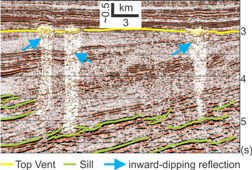 Picture: Formation of Tunguska Basin pipes and the venting of carbon gases and halocarbons to the atmosphere, from sill intrusion into organic-rich sediments. From Svensen et al, EPSL 2009 © Elsevier
Picture: Formation of Tunguska Basin pipes and the venting of carbon gases and halocarbons to the atmosphere, from sill intrusion into organic-rich sediments. From Svensen et al, EPSL 2009 © Elsevier
Moreover, Rothman et al. use a time window for the horizontal gene transfer that enabled the runaway methanogenesis that is 82 million years wide. Even if we overlook the often elastic nature of molecular clocks, and that their clock is not calibrated to fossils, that’s a time window extending from the lower Permian to the lowest Jurassic. For the mutation to have happened exactly coincident with the Siberian Traps eruptions is surely improbably lucky. The authors explain the coincidence by citing nickel fertilization by the Siberian Traps eruptions – but that would place the mutation (even more luckily) as having occurred between the Emeishan and Siberian LIPs, or else we should have had the Guadeloupian Mass Extinction.
On the other hand, Burgess stated (at the 2013 AGU fall meeting) that “intrusive and extrusive magmatism began within analytical uncertainty of the onset of mass extinction, permitting a causal connection with age precision at the ~ 0.06 Ma level.” 17 At the point of writing, new published dates on the volcanics are anticipated from the MIT team, which should clarify the issue. Regardless of initial cause, the Permian remains an extreme example of a CO2/methane greenhouse-gas generated hothouse.
Parallels

Picture: Siberian Traps © Linda Elkins-Tanton, DTM, Carnegie Institution
The point of all this is that the parallels between LIP-induced climate crises and modern climate change are becoming ever stronger and clearer. By shortening the timeframes, the rates of LIP CO2 and methane emissions are looking more comparable to today’s emission rates, even if LIP emission volumes look far larger. 10, 3, ,2 1, 18, 6, 19 It is this fast rate that is crucial for catastrophic climate change because of the ability to overwhelm fast feedbacks, versus the normal benignly-slow adjustments to carbon-cycle and insolation changes.
Some have pointed out that since we began our modern climate change in an “icehouse” era with ice sheets to melt and low starting CO2 levels, we might not reach a Permian-like hothouse. 19 In addition, since the Permian, calcareous algae have changed the way deep oceans process carbonate, providing more of a buffer. 20 But that buffer only comes into play if the deep oceans come into play, which most estimates consider will not happen for a few more centuries. 11
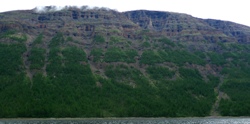 All in all, the parallels between the many LIP-linked mass extinctions in the geological record and today’s climate change offer no comfort about the legacy we are leaving for our children and grandchildren. Rather they stand as signposts for an increasingly scary future.
All in all, the parallels between the many LIP-linked mass extinctions in the geological record and today’s climate change offer no comfort about the legacy we are leaving for our children and grandchildren. Rather they stand as signposts for an increasingly scary future.
Picture: The Siberian Traps © Henrik Svensen, University of Oslo
* Howard Lee is a freelance writer based in NJ, USA. W: ylape.com
Bibliography
- Burgess, S. D., Bowring, S. & Shen, S. Z., High-precision timeline for Earth’s most severe extinction. PNAS (2014), http://www.pnas.org/content/early/2014/02/04/1317692111.short.
- Blackburn, T. J. et al., Zircon U-Pb Geochronology Links the End-Triassic Extinction with the Central Atlantic Magmatic Province. Science 340 (2013), http://www.sciencemag.org/content/340/6135/941.abstract.
- Svensen, H., Planke, S. & Corfu, F., Zircon dating ties NE Atlantic sill emplacement to initial Eocene global warming. Journal of the Geological Society, London 167, 433–436 (2010), http://jgs.lyellcollection.org/content/167/3/433.abstract.
- Cohen, A. S., Coe, A. L. & Kemp, D. B., The Late Palaeocene-Early Eocene and Toarcian (Early Jurassic) carbon isotope excursions: a comparison of their time scales, associated environmental changes, causes and consequences. Journal of the Geological Society 164, 1093-1108 (2007), http://jgs.lyellcollection.org/content/164/6/1093.abstract.
- Rodriguez, S. & Sen, G., Eruption of the Grande Ronde Basalt lavas, Columbia River Basalt Group: Results of numerical modeling. Geological Society of America Special Papers 497 (2013), http://specialpapers.gsapubs.org/content/497/259.short.
- Song, H. et al., Geochemical evidence from bio-apatite for multiple oceanic anoxic events during Permian–Triassic transition and the link with end-Permian extinction and recovery. Earth and Planetary Science Letters 353-354, 12–21 (2012), http://www.sciencedirect.com/science/article/pii/S0012821X12003640.
- Grasby, S. E., Sanei, H. & Beauchamp, B., Catastrophic dispersion of coal fly ash into oceans during the latest Permian extinction. Nature Geoscience 4, 104–107 (2011), http://www.nature.com/ngeo/journal/v4/n2/full/ngeo1069.html.
- Svensen, H. et al., Siberian gas venting and the end-Permian environmental crisis. Earth and Planetary Science Letters 277 (2009), http://www.sciencedirect.com/science/article/pii/S0012821X08007292.
- Sun, Y. et al., Lethally Hot Temperatures During the Early Triassic Greenhouse. Science 338, 366-370 (2012), http://www.sciencemag.org/content/338/6105/366.abstract.
- Sobolev, S. V. et al., Linking mantle plumes, large igneous provinces and environmental catastrophes. Nature 477, 312–316 (2011), http://www.nature.com/nature/journal/v477/n7364/abs/nature10385.html.
- Zeebe, R. E., History of Seawater Carbonate Chemistry, Atmospheric CO2, and Ocean Acidification. Annual Review of Earth and Planetary Sciences 40, 141-165 (2012), http://www.annualreviews.org/doi/abs/10.1146/annurev-earth-042711-105521.
- Zeebe, R. E. & Zachos, J. C., Long-term legacy of massive carbon input to the Earth system: Anthropocene vs. Eocene. Philosophical Transactions of The Royal Society A (2013), http://www.soest.hawaii.edu/oceanography/faculty/zeebe_files/Publications/ZeebeZachosRS13.pdf.
- Dal Corso, J. et al., The dawn of CAMP volcanism and its bearing on the end-Triassic carbon cycle disruption. Journal of the Geological Society 171 (2014), http://jgs.lyellcollection.org/content/171/2/153.abstract.
- Wright, J. D. & Schaller, M. F., Evidence for a rapid release of carbon at the Paleocene-Eocene thermal maximum. PNAS (2013), http://www.pnas.org/content/early/2013/09/13/1309188110.abstract.html.
- Zeebe, R. E., Dickens, G. R., Ridgwell, A., Sluijs, A. & Thomas, E., Onset of carbon isotope excursion at the Paleocene-Eocene thermal maximum took millennia, not 13 years. PNAS 111 (2014), http://www.pnas.org/content/111/12/E1062.extract.html?etoc.
- Rothman, D. H. et al., Methanogenic burst in the end-Permian carbon cycle. PNAS (2014), http://www.pnas.org/content/early/2014/03/26/1318106111.abstract.
- Burgess, S. & Bowring, S., Evaluating the temporal link between Siberian Traps magmatism and the end-Permian mass extinction (Invited), presented at American Geophysical Union, Fall Meeting 2013, San Francisco, 2013, http://adsabs.harvard.edu/abs/2013AGUFM.V31F.02B.
- Svensen, H., Corfu, F., Polteau, S., Hammer, Ø. & Planke, S., Rapid magma emplacement in the Karoo large igneous province. Earth and Planetary Science Letters 325 (2012), http://www.sciencedirect.com/science/article/pii/S0012821X12000258
- Kidder, D. L. & Worsley, T. R., A human-induced hothouse climate? GSA Today 22, 4-11 (2012), https://rock.geosociety.org/gsatoday/archive/22/2/article/i1052-5173-22-2-4.htm.
- Ridgwell, A., A Mid Mesozoic Revolution in the regulation of ocean chemistry. Marine Geology 217, 339–357 (2005), http://www.sciencedirect.com/science/article/pii/S0025322705000575